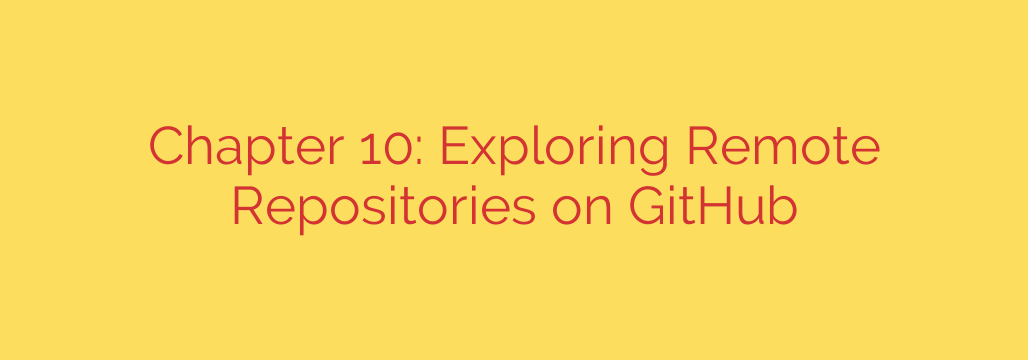
Mastering Git Remotes: A Complete Guide to Connecting and Syncing Your Code
Version control with Git is a cornerstone of modern software development, but working on your local machine is only half the story. The real power of Git is unlocked when you collaborate with others or back up your work on a hosted service like GitHub or GitLab. To do this, you need to understand and manage remote repositories.
A remote repository is simply a version of your project that is hosted on the internet or another network. When you clone a project from GitHub, you are creating a local copy of a remote repository. Git automatically creates a connection to that original repository, giving it the default shortname origin. This connection is your gateway to pushing your changes back to the source and pulling updates from other collaborators.
This guide will walk you through the essential commands for managing your remote connections, ensuring your local and remote projects stay perfectly in sync.
How to View Your Connected Remotes
Before you can manage your remotes, you need to know which ones are configured. You can see a simple list of the shortnames for your remotes by running:
git remote
However, this isn’t very descriptive. For a more useful view that shows the URLs associated with each remote, use the verbose (-v) flag:
git remote -v
This command will output a list showing the URLs for both fetching (downloading) and pushing (uploading) data.
origin https://github.com/user/project.git (fetch)
origin https://github.com/user/project.git (push)
Adding a New Remote Repository
It’s common to have more than one remote for a single project. For example, if you fork a project, you might have your own version (origin) and the original project you forked from (upstream). This allows you to pull in updates from the original project while still pushing your own changes to your fork.
To add a new remote connection, use the git remote add command, followed by a shortname and the remote’s URL:
git remote add <shortname> <url>
For instance, to add a connection to the original project repository, you would run:
git remote add upstream https://github.com/original-creator/project.git
Now, if you run git remote -v, you will see both origin and upstream listed.
Syncing with Remotes: Fetching and Pulling Data
Getting changes from a remote repository is a fundamental task. Git provides two primary commands for this, and understanding their difference is crucial.
Fetching Data (
git fetch)
Thegit fetch <remote-name>command downloads all the data from the specified remote that you don’t have yet. This includes all commits, files, and branches. Crucially,git fetchdoes not automatically merge this new data into your local working branch. It simply updates your local copy of the remote branch (e.g.,origin/main). This is a safe way to review changes before integrating them into your own work.Pulling Data (
git pull)
Thegit pullcommand is essentially a combination of two other commands:git fetchfollowed immediately bygit merge. It downloads the new data from the remote and then automatically tries to merge it into your current local branch. While convenient, this can lead to unexpected merge conflicts if you aren’t prepared.
Actionable Tip: For a safer workflow, it’s often better to run git fetch origin first. You can then use git log origin/main to see what the new commits are. Once you’ve reviewed the changes, you can manually merge them with git merge origin/main.
Pushing Your Changes to a Remote
Once you’ve committed your changes locally, you’ll want to share them by uploading them to the remote repository. This is done with the git push command.
The full command specifies both the remote name and the branch you want to push:
git push <remote-name> <branch-name>
For example, to push your local main branch to your origin remote, you would run:
git push origin main
Git will only allow you to push if your local branch is up-to-date with the remote version. If another collaborator has pushed changes since you last pulled, Git will reject your push and force you to fetch, merge, and resolve any conflicts before you can successfully push your own work.
Advanced Remote Management: Inspecting, Renaming, and Removing
Git also provides tools for maintaining your remote connections.
Inspecting a Remote: To get detailed information about a single remote, including its URLs and which remote branches are being tracked, use
git remote show <remote-name>. This command provides a comprehensive overview of the remote’s status and its relationship with your local branches.Renaming a Remote: If you want to change the shortname of a remote (for example, from
originto something more descriptive), you can usegit remote rename <old-name> <new-name>.Removing a Remote: To disconnect from a remote repository, use the
git remote rm <remote-name>command. This action only removes the connection from your local project; it does not delete the actual repository from the server.
Security and Best Practices: HTTPS vs. SSH
When adding a remote, you’ll notice the URL can be either HTTPS or SSH.
- HTTPS URLs (
https://...) are easy to use but will require you to enter your username and password (or a personal access token) each time you push or pull. - SSH URLs (
[email protected]:...) use an SSH key pair for authentication. After an initial setup, you won’t need to enter your credentials again. This is the recommended method for security and convenience, especially for projects you work on frequently.
Effectively managing remote repositories is a non-negotiable skill for any developer. By mastering these commands, you can ensure seamless collaboration, maintain a secure backup of your work, and confidently contribute to projects anywhere in the world.
Source: https://linuxhandbook.com/courses/git-for-devops/remote-repositories-git/








